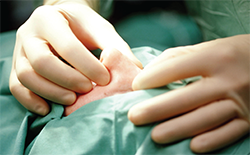
Image Credit: Phanie/Science Source
A panel of experts in rhinoplasty gathered to offer their thoughts on how they approach revision cases and to give guidance on avoiding legal pitfalls during the Triological Society session “Revision Rhinoplasty: Trends, Technology, Avoiding Litigation.”
Explore This Issue
June 2015Moderator Brian Wong, MD, PhD, professor and director of facial plastic surgery at the University of California, Irvine, said several trends have emerged over the past five to 10 years in rhinoplasty, including an emphasis on structure and flow in both function and aesthetics and, in some cases, a shift in aesthetic standards.
Technology has vastly improved since his time as a resident, he said, when using rib cartilage was an “extreme measure”; now the practice is performed routinely with fine incisions. Additionally, navigation and instrumentation have made for more precise procedures.
Case 1: Internal Valve Collapse and Nasal Obstruction
Tom Wang, MD, director of facial plastic and reconstructive surgery at Oregon Health and Science University in Portland, discussed his management of a healthy, 30-year-old woman who had had two prior rhinoplasty surgeries. She sought improvement in appearance and suffered internal valve collapse and elements of nasal obstruction.
After her first surgery, he said, she looked fine for three or four years, and then her nose started to torque. The original surgeon did work to straighten it, but no procedure was ever completely successful. The patient let it go for 10 years, but eventually the nose retwisted.
Dr. Wang noticed that the top half of the patient’s nose was quite wide, and the width pinched at the nasal tip. Additionally, she had trouble breathing out of her nose, suggesting a loss of structural support and rigidity. Dr. Wang tried to balance out the bony dorsum with the cartilaginous dorsum by rasping the dorsum and by using osteotomies to narrow the bony section, shaving down the bony dorsum for a better match.
Because the patient’s nose had a bit of additional height on the right side, he used an autospreader graft—“that is, when you release the upper-lateral cartilages, instead of trimming away the excess, you preserve that and you roll it in as an autospreader graft on the right side.”
He also used the tongue-in-groove technique to shorten the nose, which was somewhat long. But the tip had to match the reduction, and it was excessively projected, so he reduced the domes, using an incision that allowed the lateral crura to move downward to decrease alar flare.